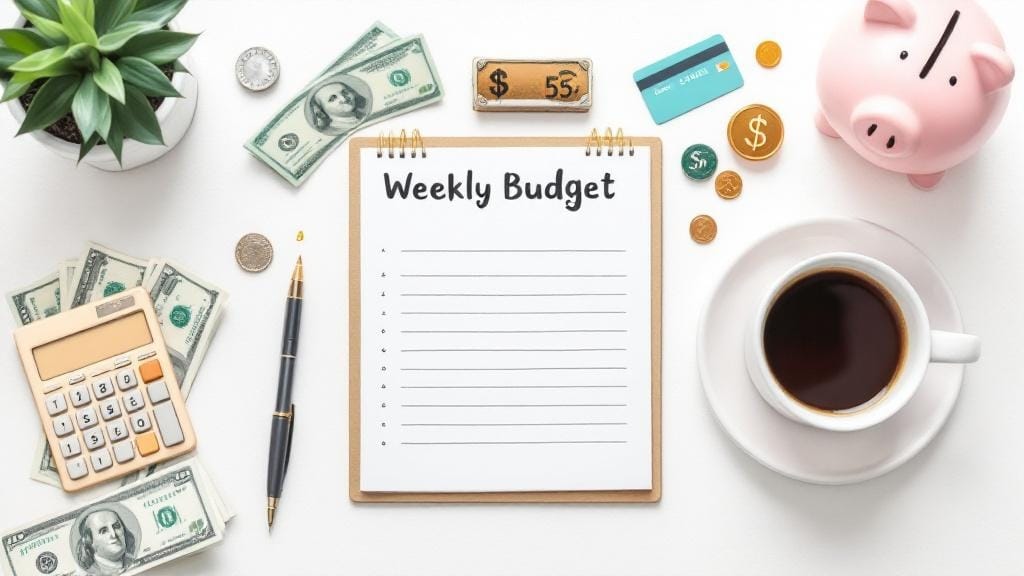Managing your finances effectively doesn’t have to be complex or overwhelming. In fact, setting a weekly budget can be one of the best ways to get control over your money and start building a healthier financial future. Whether you’re new to budgeting or looking to refine your current methods, this guide will break down the steps you need to take and provide practical tips to set a weekly budget that works for you.
By the end of this post, you’ll understand how to create a weekly budget plan that aligns with your income, goals, and lifestyle, helping you make smarter financial decisions and avoid unnecessary debt. Let’s dive into the world of weekly budgeting, and make managing your money easier!
What is a Weekly Budget?
A weekly budget is a financial plan that tracks your income and expenses for a 7-day period. Unlike monthly budgets, which can feel overwhelming, weekly budgeting offers a more flexible and manageable way to monitor your cash flow. By focusing on smaller intervals, it helps you stay on top of your finances and avoid large surprises at the end of the month.
Creating a weekly budget gives you more control over your spending and helps you stay aligned with your financial goals. Whether you’re budgeting for short-term goals like saving for a vacation or long-term objectives like building an emergency fund, weekly planning can keep you on track.
Why Should You Set a Weekly Budget?
Setting a weekly budget isn’t just about cutting down expenses—it’s about understanding where your money goes and finding ways to improve your financial habits. Here are some key reasons why you should start budgeting weekly:
1. Improved Financial Awareness
Weekly budgeting allows you to see exactly where your money is going every week. This frequent tracking helps you stay aware of unnecessary expenses and gives you more opportunities to adjust your spending before it becomes a bigger problem.
2. Better Cash Flow Management
Managing finances weekly ensures that you are always aware of your cash flow. By setting weekly spending limits, you can avoid going over your budget and accumulating debt.
3. More Flexibility
Unlike monthly budgets, weekly budgets are easier to tweak. If you over- or under-spend one week, it’s easier to adjust the next week’s budget than it is to make changes at the end of a month.
4. Faster Progress on Financial Goals
A weekly plan allows you to break down your financial goals into smaller, more manageable chunks. Whether it’s saving for a car, paying off a credit card, or building an emergency fund, weekly budgeting lets you track your progress closely.
How to Set a Weekly Budget: 6 Simple Steps
Setting up a weekly budget may sound like a lot of work, but once you break it down into simple steps, it becomes a manageable and rewarding task. Here’s how to create a weekly budget plan that works for you:
Step 1: Determine Your Weekly Income
The first step in setting a budget for weekly expenses is knowing how much money you bring in each week. Your income may vary depending on your job, freelance work, or side hustles, but it’s important to calculate your net income (after taxes).
If you’re paid bi-weekly or monthly, divide your monthly or bi-weekly income by 4 or 2, respectively, to get a more accurate weekly figure.
Example:
If you earn ₹40,000 per month, your weekly income would be ₹40,000 ÷ 4 = ₹10,000.
Step 2: List Your Fixed Expenses
Fixed expenses are recurring costs that stay the same each week, such as rent, subscriptions, or loan payments. These expenses should be prioritized in your weekly budget as they are essential and non-negotiable.
Common Fixed Expenses:
Rent or mortgage payments
Utility bills (electricity, water, internet)
Insurance premiums
Loan repayments (car loan, student loan)
Subscriptions (streaming services, gym memberships)
Example:
If your fixed expenses amount to ₹4,500 weekly (rent, utilities, and subscriptions), this is a non-negotiable portion of your weekly budget.
Step 3: Set Your Variable Expenses
Unlike fixed expenses, variable expenses change from week to week. These include groceries, transportation, entertainment, and other discretionary spending.
To set a budget for variable expenses, review your past spending over a few weeks or months to estimate your average costs.
Common Variable Expenses:
Groceries
Dining out
Gas or transportation costs
Entertainment (movies, events, etc.)
Clothing or personal care
Example:
If you typically spend ₹3,000 per week on groceries and ₹1,000 on entertainment, your total variable expenses for the week would be ₹4,000.
Step 4: Set Savings and Financial Goals
A key part of any personal budget strategy is ensuring that you’re saving for the future. Even small amounts add up over time. Set aside a portion of your weekly income to go toward savings, debt repayment, or investment goals.
Financial Goals to Consider:
Building an emergency fund
Saving for retirement
Paying off credit card debt or loans
Setting money aside for vacations or big purchases
Example:
If your goal is to save ₹2,000 each week for an emergency fund, this becomes part of your weekly budget.
Step 5: Use a Weekly Budget Tracker
To make sure you’re sticking to your weekly budget, use a tracking tool or method. There are various ways to monitor your expenses, from spreadsheets to apps.
Budgeting Tools for Weekly Planning:
Spreadsheets: A simple Google Sheet or Excel document can track both fixed and variable expenses.
Budgeting Apps: Apps like Mint, YNAB (You Need A Budget), or GoodBudget help automate the tracking process and give you real-time updates on your spending.
Pen and Paper: Some people prefer to jot down their weekly expenses manually in a notebook. This is a simple yet effective way to stay on track.
Using a weekly budget tracker helps you understand your spending habits, ensuring that you don’t overspend and stay aligned with your financial goals.
Step 6: Review and Adjust Your Budget Regularly
One of the most important steps in budgeting for beginners is regularly reviewing your progress. At the end of each week, take time to evaluate your expenses and compare them with your initial budget. This helps identify areas where you might need to adjust, and ensures that your weekly budgeting plan remains effective.
Week-by-Week Budgeting Tips:
If you have a week with lower-than-usual expenses, roll over those savings into the next week or add them to your savings.
If you overspend in one category, adjust the following week’s budget to make up for it.
Track trends to see where you can cut back or where you may need to allocate more money.
Frequently Asked Questions (FAQs)
1. What are some simple weekly budgeting methods?
To make weekly budgeting simple, start by calculating your weekly income, listing your fixed and variable expenses, and using tools like budgeting apps or spreadsheets to track your progress. Review and adjust each week based on your spending patterns.
2. How can I track my weekly expenses?
You can track your weekly expenses using a spreadsheet, budgeting apps like Mint or YNAB, or even manually writing them down. The key is consistency and reviewing your expenses at the end of each week.
3. How can I set a budget for weekly expenses?
To set a budget for weekly expenses, first calculate your weekly income, then subtract your fixed expenses. The remaining amount can be allocated to variable expenses, savings, and financial goals. Track your expenses and adjust your budget weekly as needed.
4. How do I balance income and expenses in my weekly budget?
Make sure to allocate your income to cover fixed expenses first, then assign funds to variable expenses and savings goals. If your expenses exceed your income, look for ways to reduce spending or adjust savings goals accordingly.
5. What are some budgeting techniques for the week?
Effective weekly budgeting techniques include using the 50/30/20 rule (50% for needs, 30% for wants, 20% for savings), tracking all expenses with a weekly budget tracker, and regularly reviewing and adjusting your budget based on actual spending.








Comments (0)